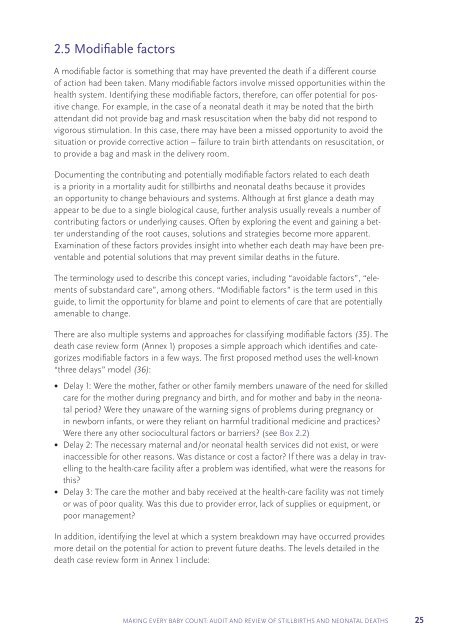Making Every Baby Count
9789241511223-eng
9789241511223-eng
Create successful ePaper yourself
Turn your PDF publications into a flip-book with our unique Google optimized e-Paper software.
2.5 Modifiable factors<br />
A modifiable factor is something that may have prevented the death if a different course<br />
of action had been taken. Many modifiable factors involve missed opportunities within the<br />
health system. Identifying these modifiable factors, therefore, can offer potential for positive<br />
change. For example, in the case of a neonatal death it may be noted that the birth<br />
attendant did not provide bag and mask resuscitation when the baby did not respond to<br />
vigorous stimulation. In this case, there may have been a missed opportunity to avoid the<br />
situation or provide corrective action – failure to train birth attendants on resuscitation, or<br />
to provide a bag and mask in the delivery room.<br />
Documenting the contributing and potentially modifiable factors related to each death<br />
is a priority in a mortality audit for stillbirths and neonatal deaths because it provides<br />
an opportunity to change behaviours and systems. Although at first glance a death may<br />
appear to be due to a single biological cause, further analysis usually reveals a number of<br />
contributing factors or underlying causes. Often by exploring the event and gaining a better<br />
understanding of the root causes, solutions and strategies become more apparent.<br />
Examination of these factors provides insight into whether each death may have been preventable<br />
and potential solutions that may prevent similar deaths in the future.<br />
The terminology used to describe this concept varies, including “avoidable factors”, “elements<br />
of substandard care”, among others. “Modifiable factors” is the term used in this<br />
guide, to limit the opportunity for blame and point to elements of care that are potentially<br />
amenable to change.<br />
There are also multiple systems and approaches for classifying modifiable factors (35). The<br />
death case review form (Annex 1) proposes a simple approach which identifies and categorizes<br />
modifiable factors in a few ways. The first proposed method uses the well-known<br />
“three delays” model (36):<br />
• Delay 1: Were the mother, father or other family members unaware of the need for skilled<br />
care for the mother during pregnancy and birth, and for mother and baby in the neonatal<br />
period? Were they unaware of the warning signs of problems during pregnancy or<br />
in newborn infants, or were they reliant on harmful traditional medicine and practices?<br />
Were there any other sociocultural factors or barriers? (see Box 2.2)<br />
• Delay 2: The necessary maternal and/or neonatal health services did not exist, or were<br />
inaccessible for other reasons. Was distance or cost a factor? If there was a delay in travelling<br />
to the health-care facility after a problem was identified, what were the reasons for<br />
this?<br />
• Delay 3: The care the mother and baby received at the health-care facility was not timely<br />
or was of poor quality. Was this due to provider error, lack of supplies or equipment, or<br />
poor management?<br />
In addition, identifying the level at which a system breakdown may have occurred provides<br />
more detail on the potential for action to prevent future deaths. The levels detailed in the<br />
death case review form in Annex 1 include:<br />
MAKING EVERY BABY COUNT: AUDIT AND REVIEW OF STILLBIRTHS AND NEONATAL DEATHS<br />
25
















